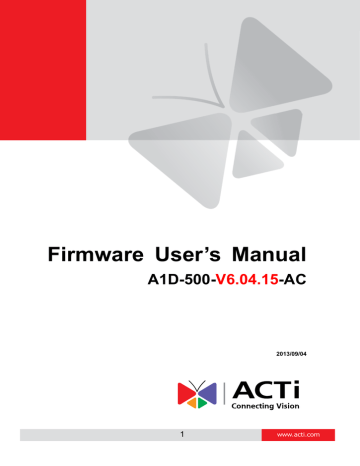
advertisement

Firmware User
’s Manual V6.04.15
Event
This section describes how to setup the Event Handler, which deals with how the IP devices respond to situations. Each IP device can have a maximum of 10 Event Rules. Each rule includes one single trigger, and one or many responses. Several types of responses are available. And there are multiple external servers for the device to interact with.
When setting up Event Handler, there are four types of settings. Event Server, Event
Configuration, Event Rules and Manual Event
Click the item before
Event
to expand the list.
Event Server
Event servers
define whom the device may interact with. They can be other servers or devices on the network, or even the camera itself.
Event Configuration
sets up a list of what to tell the other party during interaction. Event list lays down the rules and conditions about when to initiate which responses from which triggers.
The options available for Event rules are selected from the event servers and event configurations.
Event servers are classified as FTP servers, SMTP servers and HTTP servers
FTP Server
FTP servers
can receive snapshot or video uploads that are issued as part of the response from event handlers. You may setup one FTP server.
Firmware User
’s Manual V6.04.15
To setup FTP servers, make sure to enter the network address of FTP server, the Network (FTP) port, the User Name and Password of FTP account, Connection mode (Passive or Active) and
Connection time before timeout.
After changing any of the items above, press
Apply
to save the changes. The Reset button undoes the changes that had just been made but not Applied yet.
SMTP Server
SMTP servers
can send email upon request from the IP device. The email can be a simple subject and text email, or attached with snapshot / video. You may setup two SMTP servers. The device will first attempt to send the message via the Primary email SMTP server. If the first attempt fails (after the Max connecting time), then the device will attempt to send via the secondary SMTP server. If the device sends email successfully via the primary SMTP server, then it will not use the secondary SMTP server.
Firmware User
’s Manual V6.04.15
To setup SMTP servers, make sure to enable the SMTP account and choose the proper
Authentication type. There are many types available. The default is Login. We recommend you to use Auto Detection. Available authentication types include: Auto Detection, None, Login, Plain,
Cram MD5, Digest MD5 and PoP Relay. Please also enter the User Name, Password, the email address displayed as sender (can be different than the user name), Network (SMTP server) address, Network (SMTP server) Port number and Max Connection time before timeout (in seconds ).
After changing any of the items above, press
Apply
to save the changes. The Reset button undoes the changes that had just been made but not Applied yet.
HTTP Server
HTTP CGI servers
are programs that run on web sites or many devices. They can be custom programmed to perform a large variety of actions based upon the input. You can define which
CGI server to connect to here, and the user / password required to log into the target server. The actual message / command is setup in the Notification messages / URL commands section. You may define two separate CGI servers.
IP devices are also CGI servers. This means that IP devices can now issue commands to each other, which creates endless possibilities for highly coordinated response. The IP device can also give a loopback command to itself, in effect changing almost all possible settings dynamically. For detail on the commands used to control the cameras, please contact your customer representative.
An example will help you gain a better sense of how to utilize this unique function. Camera A is a fixed camera that looks at a corridor leading to the main hall. It has a motion detection window located near the point where the corridor arrives at the large hall. Camera B is a PTZ camera located in the hall, which is usually left on auto-tour patrol. When motion activity in the motion detection region triggers MD1 in Camera A, this then in turn activates an event rule in Camera A that gives out a command to Camera B. Camera B would then swivel to the preset point where the corridor leads into the entrance and switch to higher bit rate to temporarily provide clearer image. After the event ends, Camera B will go back to its normal routine in lower bit rate.
advertisement
* Your assessment is very important for improving the workof artificial intelligence, which forms the content of this project
Related manuals
advertisement
Table of contents
- 5 Connect the Equipment
- 5 Configure the IP Addresses
- 9 Access the Camera
- 11 Login
- 12 Live View
- 15 ePTZ View Mode
- 15 Panorama View Mode
- 16 Fisheye View Mode
- 17 Access the Setup Page
- 19 Date & Time
- 21 Network
- 21 IP Address Filtering
- 23 Port Mapping
- 24 HTTPS
- 25 IEEE 802.1X
- 27 SNMP Setting
- 30 Network (ToS, UPnP, Bonjour, ONVIF)
- 33 IP Settings
- 33 Connection Type
- 39 Video
- 41 Compression
- 44 Motion Detection
- 49 Day/Night
- 50 Image
- 51 Exposure / White Balance
- 55 OSD/Privacy Mask
- 58 On-Screen Graphics
- 60 Audio
- 61 Event
- 61 Event Server
- 64 Event Configuration
- 70 Event List
- 73 Manual Event
- 74 Local Storage Management
- 75 Status
- 76 Utilities
- 81 Setup
- 82 File Management
- 88 Event Handler with Local Storage
- 95 System
- 95 User Account
- 96 System Info
- 97 Factory Default
- 98 Firmware Upload
- 99 Save & Reboot
- 100 Logout